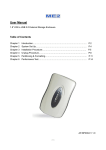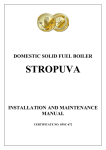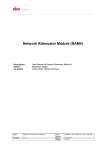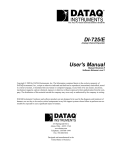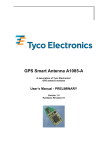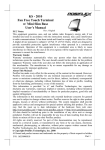Download Solar pump installation manual
Transcript
Installation Instructions for Solar Pumps USER MANUAL FOR SPS, SPC, SPSC SPQB, SPGJ SERIES SOLAR PUMPS AND PUMP CONTROLLERS www.icmsa.co.za PUMP SPECIFICATIONS Pump Model voltage (V) Power (W) Max Flow (M3/H) Max Head (M) Outlet BSP (IN) 3SPS1.0/30-D24/80 24 80 1 30 0.75" 3SPS1.3/50-D24/140 24 140 1.3 50 0.75" 3SPS1.8/80-D24/210 24 210 1.8 80 0.75" 3SPS1.8/100-D36/270 36 270 1.8 100 0.75" 3SPS1.8/120-D36/500 36 500 1.8 120 0.75" 3SPS2.3/140-D48/750 48 750 2.3 140 0.75" 3SPS2.3/160-D72/1000 72 1000 2.3 160 0.75" 3SPS2.3/180-D110/1300 110 1300 2.3 180 0.75" 4SPS3/60-D36/500 36 500 3 60 1" 4SPS3.6/80-D48/750 48 750 3.6 80 1" 4SPS4/100-D72/1000 72 1000 4 100 1" 4SPS4.2/120-D110/1300 110 1300 4.2 120 1" Diameter & length (MM) 76*400 76*460 100*480 100*550 3SPC2.6/32-D24/300 24 300 2.6 32 1" 76*620 3SPC2.8/52-D36/500 36 500 2.8 52 1" 76*820 3SPC3.0/85-D48/750 48 750 3 85 1" 76*940 3SPC3.2/106-D72/1000 72 1000 3.2 106 1" 76*1060 4SPC5.0/28-D24/250 24 250 5 28 1.25" 100*540 4SPC5.5/38-D36/400 36 400 5.5 38 1.25" 100*650 4SPC5.5/58-D48/750 48 750 5.5 58 1.25" 100*680 4SPC6.0/72-D72/1000 72 1000 6 72 1.25" 100*740 4SPC10/30-D48/750 48 750 10 30 1.5" 100*540 4SPC10/44-D72/1000 72 1000 10 44 1.5" 100*650 4SPC10/57-D110/1300 110 1300 10 57 1.5" 100*680 Pump Model voltage (V) Power (W) Max Flow (M3/H) Max Head (M) Outlet BSP (IN) Diameter & length (MM) 4SPSC5.0/28-D24/250 24 250 5 28 1.25" 100*540 4SPSC5.5/38-D36/400 36 400 5.5 38 1.25" 100*650 4SPSC5.5/58-D48/750 48 750 5.5 58 1.25" 100*680 4SPSC6.0/72-D72/1000 72 1000 6 72 1.25" 100*740 4SPSC6.5/98-D110/1300 110 1300 6.5 98 1.25" 100*880 4SPSC10/30-D48/750 48 750 10 30 1.5" 100*540 4SPSC10/44-D72/1000 72 1000 10 44 1.5" 100*650 4SPSC10/57-D110/1300 110 1300 10 57 1.5" 100*680 4SPSC15/21-D72/1000 72 1000 15 21 2" 100*540 4SPSC15/28-D110/1300 110 1300 15 28 2" 100*620 4SPSC23/21-D110/1300 110 1300 23 21 3" 125*700 4SPSC28/13-D110/1300 110 1300 28 13 3" 125*710 6SPSC46/7-D110/1300 110 1300 46 7 4" 125*690 Operating principle Solar photovoltaic panels convert sunlight to electrical energy which is then passed to the solar pump controller. The solar controller stabilises the voltage and creates a three phase output to drive the electric motor of the pump. If backup batteries (optional) are available the pump controller can charge them. The stored energy can be used at a later date when the sunlight may not be adequate to drive the pump. Sensors are also connected to the controller and can be used to protect the pump from running dry, as well as to automatically turn the pump off when a water tank is full. The system can be remote from traditional power sources and fully automatic, with no on-going electricity charges. If you have not purchased a complete system from your supplier the following formulae will be useful: Selecting the components for the pumping system Solar PV panel (solar photovoltaic panel) selection Use the following formula to select the correct solar PV panel(s): Power of pump (watts) x 1.3 ~ 1.6 = power rating of solar PV panel(s) in watts For example: A 300 watt pump needs a minimum of 390 watts of PV panels to drive it: 300 watt pump x 1.3 = 390 watt PV panel • You may need combinations of panels, especially for the larger pumps. • When you have panels in parallel, add the current of the panels and the wattage. Note: If connecting in parallel you will need Schottky Diodes in series with each panel. • When using panels in series add the voltage and the wattage. For example: 2 x 12 volt 100 watt panels in parallel become a 12 volt 200 watt system 2 x 12 volt 100 watt panels in series become a 24 volt 200 watt system Note: Your pump supplier will be able to help you with panel selection The controller will already be matched to the pump by your supplier. Battery selection if you want to pump when there is not enough sun If you want to add batteries please note that you will need an additional solar charge controller (not supplied in the kit) and you will need to double the number of PV panels. The extra PV panels are required to charge the batteries while the pump is pumping. The cheapest option is to: a) try to fill an elevated header tank or b) if you have no elevation locate the tank near a utility power supply so you can pump water from the tank using a mains powered pump. You must use deep cycle batteries, not car batteries. Deep cycle batteries are designed to take much lower continual discharges than regular car batteries. Deep cycle batteries normally have an ’amp hour’ rating shown as AH, e.g. 100AH. Use the following formulas to calculate battery size required for backup. Please note that even with a deep cycle battery, discharging it to a low level will shorten its life. This is why we use 60% as a discharge level. Use the following formulae to select the correct battery or batteries: Current drawn by the pump = pump power divided by the voltage 300 watts = 25 amps divided by 12 volts 100 AH divided 25 amps x 0.6 of backup with the discharged to 60% = 2.4 hours battery being In the case of a 24 volt 300 watt pump: 300 watts divided by 24 = 12.5 amps 2 x 100AH 12volt batteries in series = 100 AH at 24 volts 100AH 4.8 hours of backup divided by 12.5 amps x 0.6 • Batteries in parallel: add the AH, voltage stays the same. • Batteries in series: add the voltage, AH stays the same. Question: I want to have backup for 8 hours with a 300 watt 24 volt pump. How many AH do I need? Answer: 300 watts divided by 24 volts = 12.5 amps. 8 hours divided 0.6 x 12.5 amps = 166AH (2 x 166 AH 12volt batteries in series) Parts List Solar pump 1pc Controller 1pc Impeller 1pc Cable Connector 4pcs OR or Water Level Sensor 4pcs Rope 1pc Manual 1pc Installation 1. Open the package and check that all the parts have been supplied. 2. Before you start wiring, ensure that the control box switch is in the off position. The pump needs to be submersed in water for at least 15 minutes before power is applied to it. Water is the lubrication for the pump and if it is not ’preconditioned‘ properly the bearings will not be adequately lubricated. This will result in premature wear and failure of the pump and will void the warranty. Connecting a longer cable to the pump (cable must be at least 1.5mm2 section) Use the parts contained in the cable connector kit to connect a longer supply wire to the pump. If you don’t have a heat gun to shrink the tube, the barrel of your soldering iron will do, or you can use a butane torch (but with great care so you don’t melt the insulation or set it on fire). Bare the insulation back as shown above. 1. Lay out the components needed to make the join. 2. Put the large diameter piece of heat-shrink over the main cable and then the smaller diameter pieces over the individual wires. Keep the heat-shrink back away from the joints as you solder them. Any heat transfer will prematurely shrink the heat-shrink. 3. and 4. Slide the small heat-shrink over the soldered joints and heat using a heat gun or alternative heat source to shrink the sleeve down over the wires. 5. Slide the large diameter heat-shrink over the completed joint and shrink to it. IMPORTANT: Place the pump in water before you start wiring the controller box. This will allow the pump to go through the pre-conditioning required. Do not put the pump in its final position until you have tested it, unless it is easy to see and remove. Wiring the control box 1. Wire the pump, panels and optional battery to the control box as per the wiring diagram below. When wiring the pump do not worry about the wiring orientation, just connect the pump wires to the controller making sure they do not touch each other. You will test the system later. If you find that the wiring is incorrect the pump will run backwards and you will only have to swap over two wires to get it running correctly. You have a 50:50 chance of getting it correct the first time. If you are intending to use a battery use the bottom wiring diagram. Make sure the polarity is correct - plus to plus, minus to minus. Charge controllers generally have the following connections - Battery, Panel and Load either written or in pictorial form. The pump controller solar PV input is connected to the load terminals of the charge controller. As a safety margin we recommend that the charge controller be able to supply at least 1.5 times the pump requirements. Basic formula: Load (amps) = pump wattage / voltage = amps. Amps x 1.5 = charge control load, e.g. a 300 watt 24 volt pump. 300/24 = 15 amps. 15A x 1.5 = 22.5 amps. The charge controller must be able to supply 22.5 amps to the load at 24 volts. Caution: When wiring a battery be very careful not to reverse or short the terminals. While the voltage is low the current capability is in the order of hundreds, if not thousands of amps and you can do serious damage. We advise you to remove all metal wrist bands or watches before you start. A short across a metal watch strap will result in it glowing red hot in seconds, causing very serious burns. Solar PV panels, when connected together, can also produce a lot of energy so caution must also be exercised here as well. Laying a dark cloth over the panels to shade them is a good precaution to reduce the power output. 2. It is important that the water sensors are connected properly. The water low (WH) and water common (WC) are very important because they protect the pump from running dry. Do not link out WH under any circumstances (the only exception is for troubleshooting). The sensors The sensor terminals TC and TH can be left disconnected if you are not using a header tank or don’t care if the water flows out on the ground once the tank is full. The sensor probes are all the same – they just have different coloured wiring. For clarity we recommend you use the probes with white wires as the common probes (WC and TC) and the other colours for WH and TH. Testing the pump The pump must be under water at all times and should have been pre-conditioned for at least 15 minutes. Do not attempt to test the pump even for a moment without it being submerged or permanent damage will occur. You will need a large container so the pump does not pump it dry in seconds. The WH and WC sensors must be in the water. TH also needs to be out of water or not connected. 1. The PV panels need to be in full sun. Turn on the control switch. The pump has a ‘soft start function’ and will start after 6 seconds and then spin up to full speed in the next 6 seconds. If the wiring is correct the pump will restart and the pump will run continuously. If the pump does not pump much water it is possible the wiring of the pump is incorrect and it is running backwards. To correct this, switch off the control box and reverse the wires to terminals 1 and 2. Switch the controller on again and the pump should now be working correctly after self-diagnostics. 2. Test the sensors one at a time. Pull the sensor connected to WH out of the water. The pump should stop immediately. Put the sensor back under water and the pump should start. To test TH and TC start the pump with TH and TC out of the water. Put TH and TC in water. The pump should stop. Pull the TH sensor out of the water and the pump should start again after 3 minutes. Installing the pump 1. Attach a durable rope or stainless steel cable to the top of the pump using the mounting hole. Make sure the rope or cable is longer than the depth at which you want to install the pump. This is used to raise and lower the pump. Never use the power cable to do this. 2. Very important! Attach the WH sensor with a tie wrap to the pump cable so it will be at least 0.5 metres above the pump body when it is installed, the higher the better. The WC sensor needs to be placed below the WH sensor. 3. Connect the water line and lower the pump into the bore hole, well, stream lake etc. Please note the pump must be operated vertically so the bearings have no excess side thrust on them and the water should be clean with no corrosive materials e.g. sand in it. The pump must be at the correct depth. Do not put the pump any deeper than 20 metres in the water. Depending on the water source the level can drop when water is drawn off so the sensors need to be placed appropriately to account for this, otherwise it will be stopping and starting. Dos and don’ts Do keep the pump under water at all times when operating. Do be careful with wiring. Do remove the pump if not using it for a long time and wipe the screw and body. Wipe with vegetable oil. Do make sure the pump has adequate water around it during pumping. If the sensors are activated there will be at least a 3 minute delay between pumping sessions. Do put your solar PV panels in a sunny position facing true north (southern hemisphere) or true south (northern hemisphere). If the panel angle is fixed then an angle equal to your latitude will be a good compromise. Don’t run the pump out of the water, even momentarily. It will void the warranty. Don’t bypass the WH sensor except to troubleshoot. Don’t adjust the regulation bolt in the base of the pump. It is factory set. It will void the warranty. Don’t use the pump in dirty water. Premature wear will not be covered by warranty. Troubleshooting using the pump controller indicator lights Power light: If everything is operating properly this will be green. If it is not green then the voltage may be too low (not enough sunlight), the pump is drawing too much current (head too high) or the controller temperature is too high (put it in a cool position with plenty of air circulation). MPPT light: This is normally green and if the pump is operating properly it will stay green. If it is not green then the voltage may be too low (not enough sunlight), the pump is drawing too much current (head too high), the controller temperature is too high (put it in a cool position with plenty of air circulation), too much current or the controller temperature is too high. Well level light: If this lamp is off the water level in the well has dropped below the sensor (WH) and it is protecting the pump from running dry. Remedy: Lower the pump deeper into the water so when the water is drawn off the water level stays well above the pump. Tank light: If the light is red the tank is full so the pump will stop. If you have linked this out it will always be off. If the light is off then the pump will pump provided there is enough sunlight. Limited 1 Year Warranty 1. The manufacturer extends only to the original consumer purchaser a limited warranty against defects in material and workmanship for a period of three years from the date of purchase. This warranty covers the pump, controller and sensors. 2. The manufacturer or authorized factory representative will repair, or at its option replace any defective part or parts of the product free of charge. In the event of a malfunction the purchaser must return the product to an authorized dealer/agent at their expense. The warranty is limited to the repair or replacement of the product and the manufacturer or its dealers disclaim all liability for indirect and/or consequential damages such as any installation charges. 3. The warranty does not apply when the equipment has not been installed as per the instructions or damage has occurred through abuse, carelessness, improper installation, accident of mishandling during shipment, connecting to an improper voltage or it has been serviced by anyone other than an authorized factory representative. 4. A purchase receipt or invoice for proof of purchase must be presented to claim warranty. 5. All repairs not covered by warranty or outside the warranty period will be charged at normal rates.












